Hi friends~ Tiny Pony Apothecary will be documenting the plants in the gardens and wilds that we cultivate and harvest for medicine-making and pleasure. We’d love to have you follow our journey this season. . .




Hi friends~ Tiny Pony Apothecary will be documenting the plants in the gardens and wilds that we cultivate and harvest for medicine-making and pleasure. We’d love to have you follow our journey this season. . .





This flower essence is for everyone but especially supportive for teens, peri-menopausal folks, and those of us who make queer magic. Blue cohosh flower essence supports us in sifting through the hesitancy or anxiety we might feel around sex and sexuality, particularly during times of transition, change, and growth, and encourages openness and acceptance of the sacred ways in which we are each made to contribute to the creative and sensual energies of the planet in this body and lifetime.

#foresttherapy #sexpositiveherbalism #caulophyllumthalictroides #rampseasonyall #queermagic #vitalism #feministmedicine #floweressence #subtlebody

When the first spring witch hazel flowers waves their soft fringes at you know maybe it’s going to be okay.
The physiological medicine of witch hazel’s astringency serves to draw lax or sagging tissues together, firming and supporting the structures of the body. In the subtle energetic body, the flower essence also acts in this drawing capacity. Whether pulling the soul upward from the darkness of winter or from a stuck or stagnant location where decision-making feels impossible, the flower essence of witch hazel encourages movement supported by grounded self-knowing and the cultivation of internal light which reaches for the external world. In this way, the flowers of Chinese witch hazel are applied to the subtle body for the purposes of composting, transforming, and releasing trauma and trauma-related stress from the cellular levels of the body.

#herbsfortrauma #plantsgotyourback #queercare #resilience #plantmedicine #subtlebody #witchery
My is this fungus en vogue.
In the last year I’ve enjoyed sampling any number of variations on a chaga chai recipe, and nearly every Vermont abode I’m invited into boasts a good size chunk sitting on the mantle or on a kitchen shelf. No matter how strongly my dad instilled in me a resistance to following the crowd, I can’t help it — chaga is pretty great, no bones about it. I don’t even have to make contorted mushroomy faces when I drink the decoction (I’ll make sure to take a photo next time I send Reishi tea down the hatch).

What I like about this herb is: it’s not delicate or lithe or sexy. My teacher 7song, of the Northeast School of Botanical Medicine, used to tell us he thought it looked like the birch was growing a nose. Chaga is a humble-looking thing, barely revealing itself inside the bark tissues it manages to reinvent, a re-maker, a remodeler, collaborating sinuously with the bark it inhabits. The thick sooty black-brown of its craggy outer layers protects a golden corky crumble laced with cream-colored veins, like someone’s gluten-free caramel brownie attempt gone wrong and then burnt. While the latter is a fairly common occurrence, the former is not.
You have to acquire your chaga eye when walking in the birch woods. Inonotus obliquus is magical in the way that woodland creatures are: I can only find it when the mushroom decides to be seen, and its anyone’s guess whether I’ll be able to take it home with me for medicine. Some mushrooms I’ve encountered at head-height or at least within arm’s reach, but most grow between 10 and 30 feet off of the ground. I’ve enacted many a Buster Keaton-goes-camping scene at the bottom end of a long stick, swiping inelegantly at the extrusion as if exerting myself in a blindfolded pinata attempt on stilettos. Or else I’m with someone who is inevitably the larger of the two of us, and I find myself balancing on shoulders with a hatchet in one hand and the chaga crumbling piecemeal on my pal’s head.
Good thing I’m in the circus. But we were talking about chaga.

BOTANY, PHYTOCHEMISTRY, & PHARMOCOLOGY
Most of what we know about chaga as medicine comes from Russian folk medicine and the last 40 years of research, which has demonstrated through studies numbering in the thousands that these mushrooms exert measurable pharmacological effects on the immune, hormonal, and nervous systems. Chaga, scientifically referred to as Innonotus obliquus, are polypores that hardly look like their kin; the common name “clinker polypore” helps describe the tumor-like appearance which bears little resemblance to the other polypores, which are shelf-like and porous on their undersides. Chaga are classified as Basidiomycetes mushrooms, of which 200 species appear to be used medicinally, and are found growing parasitically on white birch, alder, and beech — plentiful in the northeastern United States, Canada, Japan, northern Scandinavia, and Russia — although only the fruiting bodies of those growing birch are used medicinally. The most prized chaga specimens seem to grow on black birch trees in Siberia, which some researchers and enthusiasts say is 40,000 times more densely packed with antioxidants than any foods or supplements found in a natural food store. Unlike many other mushrooms, chaga grow on living substrates, so mind the adage: dead tree, dead chaga.
Nearly 500 years of documentation show that this gnarly polypore has been used in the folk medicine traditions of Russia and Eastern Europe. In 1955, pharmacies in Russia, Eastern Europe, and Japan began selling a refined extract of chaga specifically for stomach and intestinal disorders. The current resurgence of interest in this medicine has resulted in research that suggests its use for many aspects of immune function, including chronic fatigue, tuberculosis, influenza, autoimmune digestive disorders, HIV, diabetes, and a variety of cancers.
One way that herbs are view through allopathic practices is which conditions, symptoms, or diseases they seem to effect. Constitutional herbalism also looks at herbs via their particular energetics (heat, movement, moistness, stimulation — what i think of as an herb’s personality) and its actions (antioxidant, anti-inflammatory, anti-fungal, anti-mutagenic, anti-hyperproliferative, anti-hyperglycemic properties). Chinese medicine calls this herb sweet, cooling, balancing, grounding — that is, the flavor, the temperature, the pulling in of extremes, the sending of energy down through a center. I particularly prize chaga for its reasonable nature, which benefits folks struggling with autoimmune conditions. In its modulating and balancing capacities, chaga can help stimulate an ailing or underactive immune system but soothe an overactive misfiring immune system. That’s a nice friend to have.

Superoxide Dismutase is an enzymatic ally that combats free radical damage through protective and reparative cellular mechanisms. Research tells us that chaga contains the highest concentration of Superoxide Dismutase (SOD) known to planet Earth. For those of us at risk for DNA mutation created by excess free radicals due to radiation and pesticides and other pollutant — oh wait, that’s all of us — we might do ourselves some good by sitting down with a cup of chaga tea on the daily. The mutagenic activity evident in compounds isolated from chaga shows promise in preventing gene-mutation-related conditions such as sickle cell anemia and Downs Syndrome.
While herbalists worth their salt will tell you that isolating a single “active” compound is not the best way to take medicine, such research does yield some information about a medicine’s constituents. Like many other medicinal mushrooms, chaga contains polusaccharides known for their immuno-stimulating actions. At the University of Helsinki, Finnish researchers have found several active lanosterol-type triterpenes, known for their antitumor properties, and most vigorous of which is called inotodiol. The anti-cancer compound betulin is produced in birch trees and absorbed by the chaga fungus, which concentrated the betulin and transformed it into a compound that can be taken orally by human beings.
Which, folks, is really pretty awesome.
There are so many idiosyncratic and quirky facts about chaga that I felt compelled to compile them outside of fluent prose.
+ Russian mushrooms hunters may scale trees with ropes and harnesses for the best booty.
+ Folks say that certain old chaga hunters use a shotgun to blast the higher specimens loose from their moonings.
+ High altitude Siberian prizes have been known to weight over 10 lbs.
+ Only one birch in 15,000 bears chaga, and the ideal age for a good fruiting body is 25 years old.
+ The DNA of Siberian chaga is 30% per cent closer to humans DNA than that of plants.
+ Literary Nobelist Alexander Solzhenitsyn is said to have brewed a variety of medicinal mushroom teas, describing chaga in detail in his writing.
MAKING A GOOD CHAGA DECOCTION 
How does one sweetly solicit this tough crumbly creature to part with its medicine? Most folks agree that a stiff decoction is the thing.
Like burdock, chaga has some constituents that come out in rolling boil and others that transfer to the menstruum in cool water. Most chaga connoisseurs agree that it is best to granulate the specimen (tools of choice include coffee grinder, vita-mix, hammer, and steel mortar and pestle) and then to make an aqueous extraction by soaking the mushroom in cool water for 12-25 hours before bringing to a rolling boil (decocting) for 1-2 hours, or vice versa. If one were to make a tincture, it may be wise to combine such a decoction with a separate tincture, so that the high-proof alcohol does not destroy the polysaccharide molecules in the decoction.
Check out my morning thunder recipe; chaga is a great addition to it. Also, one of the newest editions to the Tiny Pony Apothecary is the Glitter Bones Elixir . . . take a peek!

SOURCES & RESEARCH
Lull, C., Wichers, H.J., Savelkoul, H.F.J. (2005). Antiinflammatory and Immunomodulating Properties of Fungal Metabolites. Mediators and Inflammation. 2005(2): 63–80.
Anticancer effects of fraction isolated from fruiting bodies of chaga medicinal mushroom, Inonotus obliquus. http://www.ncbi.nlm.nih.gov/pubmed/22135889
Extract of chaga mushroom (Inonotus obliquus) stimulates 3T3-L1 adipocyte differentiation. http://www.ncbi.nlm.nih.gov/pubmed/21031614
Chaga mushroom extract inhibits oxidative DNA damage in human lymphocytes as assessed by comet assay. http://www.ncbi.nlm.nih.gov/pubmed/15630179
Chaga mushroom extract inhibits oxidative DNA damage in lymphocytes of patients with inflammatory bowel disease. http://www.ncbi.nlm.nih.gov/pubmed/18997282
Chemical characterization and biologicalactivity of chaga (Inonotus obliquus), a medicinal mushroom. http://www.ncbi.nlm.nih.gov/pubmed/25576897
Mycolivia Medicinal Mushrooms The Essence of Nature and Technology. http://www.mycolivia.com/chaga-mushroom/
Alan Muskat and Co. Chaga. http://www.notastelikehome.org/chaga.php
If I was better at handling winter, I’d be moving to Maine.
In mid-July, despairing of finding any sizable quantity of St. John’s wort for my apothecary and feeling restless in what Vermonters call “heat,” I headed to the Maine coast with a companion to find out what my friend Micah has been doing these past four years.
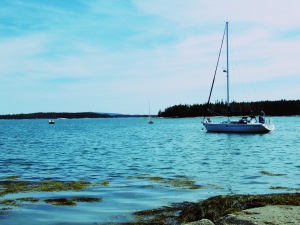 Turns out, he’s been living on a magical island that you can only get to by boat. Micah is the founder of the Atlantic Holdfast Company, a small labor of hand-harvested love, bringing you the loveliest cuts of seaweeds that Neptune is willing to part with. He spends his time harvesting vegetables from ledges awash in salt water with a serrated knife, under the curious gazes of dog-like seals who venture in only occasionally for a nibble.
Turns out, he’s been living on a magical island that you can only get to by boat. Micah is the founder of the Atlantic Holdfast Company, a small labor of hand-harvested love, bringing you the loveliest cuts of seaweeds that Neptune is willing to part with. He spends his time harvesting vegetables from ledges awash in salt water with a serrated knife, under the curious gazes of dog-like seals who venture in only occasionally for a nibble.
Micah picked us up from a dock on the southern tip of Deer Isle in a friend’s lobstering boat, which we traded halfway through the Penobscot Bay for a much smaller vessel with an outboard motor. Micah positioned my pal and me just so in the boat, in order to balance the weight in the laden vessel. I learned quickly to tuck my feet under a weighty cooler to prevent myself from being cast overboard in the substantial wind.
 After a good half hour of motoring out, we arrived thoroughly goosebumped at a small isle covered in St. John’s wort, and so I was immediately satisfied, notwithstanding the epic kelp harvesting, rock-hopping, beach-combing, and roasted goat and lobster dinner in our immediate futures.
After a good half hour of motoring out, we arrived thoroughly goosebumped at a small isle covered in St. John’s wort, and so I was immediately satisfied, notwithstanding the epic kelp harvesting, rock-hopping, beach-combing, and roasted goat and lobster dinner in our immediate futures.
The daily activities of seaweed harvest are of the gutsy gritty romance that characterizes many of Maine’s industries. Several hours before the lowest tide of the month, my friend and I headed down to the barn where the seaweed and wetsuits were hung to dry. My pal and I struggled into our wetsuits as if the suits were actually exercise accoutrements designed to help us achieve and sustain effortful contorted positions. Half an hour later, after accomplishing ten chores in as many minutes, Micah came along and slipped into his suit like an easy second skin over rearrangable limbs.

We piled more equipment into the boat, waded in, and pushed off, the spray upon my glasses offering an impressionist’s view of the sea and sky. After another half hour, we arrived at several exposed ledges that Micah identified as prime seaweed territory. With a serrated knife in my right hand and in my left the rope to an inner tube with a harvesting basket stuffed in it and floating upon the curl, I threw myself overboard into four feet of sucking tides and slippery seaweed-covered rock.
We were after Digitata, the many-fingered kelp, and all the while the spidery Alaria fronds curled raggedly around our waists and thighs as the tides tried their damnedest to swallow me or at least laugh insanely as my tiny human attempt to balance upon two legs. To harvest the Digitata required that I reach into water up to my shoulder and grasp the stipe with an inarticulate gloved hand. The stipe was often as thick around as I could grasp, and without allowing the chaos to interfere with my sawing, I’d cut through the meat of it in order to retrieve 2-4 inches of stipe and all of the frond. Micah had an eye for the amount he wanted to harvest in order to manage the patch sustainably. Just when I was starting to wonder whether I was in control of the bucket full of seaweed or the bucket was in control of me, Micah shouted for us to hoist ourselves back in the boat, a feat which I was able to execute inelegantly thanks only to the quantity of pull-ups required in the study of acrobatics.
This all occurred between 4:30 am and 7:30 am.
Let me be clear, I was inordinately thrilled by every single moment of the harvest and would encourage anyone looking for a foraging adventure to test her sea legs. Pay no mind to the sizable seal nosing at your toe.
Being the smallest of our threesome — I have since learned from a Vermont natural science museum that the smallest animals often don’t survive the winter simply because of mass — I went directly under the covers upon our return to the cabin on the flower-covered isle and shivered for the better part of two hours. When I woke, I ate an enormous quantity of bacon and eggs, feta and cucumbers, walnuts and dates, and squares of dark chocolate.
Around noon, we returned to the boat, which had been pushed in to us by the tide, and we spent the happy part of an hour hauling buckets of wet seaweed up to the barn. My friend and I used a little yellow cart, which I pushed and he pulled, and we’d delivery the slippery vegetables to barn, where Micah had designed several ingenious sets of pullies and racks and ropes to haul the seaweed from the bottom of the barn to the second story.
 Seaweeds begin to exude alginates after an hour of so out of the water, and so I had the sensation of having my hands covered in mermaid sneezes as I hung the muppet-like plants on thin wooden sticks in their specially-constructed racks.
Seaweeds begin to exude alginates after an hour of so out of the water, and so I had the sensation of having my hands covered in mermaid sneezes as I hung the muppet-like plants on thin wooden sticks in their specially-constructed racks.
Processing plants — shucking corn, pruning garlic, stripping leaves from dried tulsi, pinching golden ground cherries from their papery lantern husks — is one of the most intimate times for human-plant and human-human bonding. The plants slither or crumble or shed all over you according to their natures, and we homo sapiens catch up on all the gossip since we last we met: what its like to find a date in rural New England, the after-hours shenanigans of the neighboring lobstermen, the best way to butcher a goat, farming versus foraging. The usual.
After hanging the Digitata to dry, I had another nap, and then in the late afternoon my comrade and I wandered the perimeter of the island, past a giant elderberry tree covered in soft flowers, over rocky inlets ridden with buoys and lobster crates washed ashore, past Rosa rugosa thickets heavy with green hips, through patches and patches of wild raspberries, and up into the arms of a giant old rowan tree covered in the droppings of a raccoon tucking in to the early raspberries.
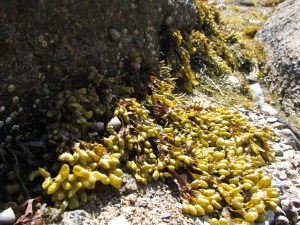 Along the shore we gathered the bladderwrack, which lay like the pocketed hair of mermaids, sucked at by the rocks at the water’s edge. We bent amid the tumble of boulders to snip the seaweed and pile it into our buckets. Bladderwrack has an odd mineral butter aroma, strongly of the sea and also sort of animal-ish. Micah recommended that we start to dry the seaweed in the car on the way home, and then grind it, as it was best as an additive or condiment to dishes or smoothies.
Along the shore we gathered the bladderwrack, which lay like the pocketed hair of mermaids, sucked at by the rocks at the water’s edge. We bent amid the tumble of boulders to snip the seaweed and pile it into our buckets. Bladderwrack has an odd mineral butter aroma, strongly of the sea and also sort of animal-ish. Micah recommended that we start to dry the seaweed in the car on the way home, and then grind it, as it was best as an additive or condiment to dishes or smoothies.
So that’s what I did. First on the porch in the sun, then finished it off in my dehydrator. A coffee grinder did the job just fine. What a particular plant this is! Here are some things I’ve learned about it since.
Fucus vesiculosis (the species name meaning “little vesicles,” for the sealed air pockets that float the stuff) is the Latin binomial for the brown seaweed bladderwrack, a form of kelp famous for its ability to stimulate sluggish thyroid function. High in a form of iodine which is the immediate precursor to the thyroid hormones T3 and T4, bladderwrack is also highly nutritive, demulcent, and stimulating to cellular metabolism. The specific indications for use of this sea vegetable medicinally include both energetic and constitutional pictures as well as discreet diagnoses.
+ Depeletion: Bladderwrack in dense in micronutrients besides iodine, including calcium, magnesium potassium, sodium, silicon, iron, vitamin D, many B-complex vitamins, as well as essential fatty acids. The powdered sea vegetable is useful in debility, poor digestion, post-surgery, convalescence, postpartum, and other situations where remineralization is necessary. Particularly indicated for lethargy, dry skin and membranes, constipation resulting from dryness, and slow cognitive and physical development in children.
+ Chronic and Systemic Inflammation: Hot baths, compresses, and oral supplementation with bladderwrack is often recommended in rheumatic conditions. Treatments have been documented to relieved sore and achy joints and muscles as well as stimulate cartilage growth.
+ Adrenal and Immune Function: Studies have shown bladderwrack to improve duration and quality of sleep, promote tissue healing, and support anti-viral activity. Fucoidan is a compound found in brown seaweeds which has been shown to interfere with all stages of viral attack as well as will proliferation of human cancer cells. Dr. Drum even points out that all human cells studied have receptors for Fucose, the end-group sugar on the Fucoidan compound.
+ Metabolic and Cardiovascular Function: Bladderwrack added into the diet delays hardening of the arteries, lowers chronically high blood pressure, and stimulates cellular metabolism — all conditions correlated with low thyroid function.
SAVORY MORNING OATS!
This is my chance to share my favorite breakfast recipe, an not-sweet oatmeal recipe that I prefer for its ability to sustain the body through cold and hard-working mornings.
INGREDIENTS
Steel-cut or rolled oats, soaked 2-24 hours, drained 1 tablespoon ground bladderwrack or other seaweed 1 shredded carrot 2 tablespoons sunflower seeds, pumpkin seeds, sesame seeds, and/or walnuts 1-2 pats of butter or coconut oil 1-2 teaspoons fresh-ground black pepper Nutritional yeast or miso as desired
+ Bring water for oats to a boil, adding an extra half-cup to account for seaweed addition. + Upon boil, add oats, ground bladderwrack, and nuts and seeds. + Reduce to a simmer until oats are tender, as desired + Remove from heat and add remaining ingredients. + Easy peasy!
Maude Grieve. Bladderwrack. A Modern Herbal. https://www.botanical.com/botanical/mgmh/b/bladde54.html
Ryan Drum. Sea Vegetables for Food and Medicine. http://www.ryandrum.com/seaxpan1.html
Herbal Riot. The Magickal Uses of Bladderwrack. http://herbalriot.tumblr.com/post/56686839194/the-magickal-uses-of-bladderwrack
UPDATE: Hello friends! Many folks in the herbal community are becoming increasingly concerned about ethical wildcrafting and human carelessness when wild harvesting plants for medicine. Ghost Pipe in particular is a vulnerable creature and Sean Donahue has written eloquently about how we humans can do damage both accidentally and on purpose. Please check out his post in addition to what I’ve offered here. It’s good to know this plant, and its good to refrain from its medicine if feel we don’t have its full blessing. If its possible for your body and life structures, venturing out and sitting at the feet of the wild-growing medicines will not only help you learn what the plant teaches, but help us understand the anti-materialist practices and potential of energetic and subtle-body medicine.
+ + +
There is a lot of lore and and witchy writing out there about this succulent and eerie little creature, and I am no more immune to its draw than the next plant nerd. This summer I’ve been quite aware of the small clusters of these nodding flowers as they observe my human doings en route to the swimming spot or napping in the hemlock groves.
If you’ve never sat with Ghost Pipe, allow me to describe how it grows with two or twelve companions in stands no more than ten inches high, clustered through damp acidic coniferous groves and often in companionship with Ganoderma (Reishi) and Mitchella (Partridge Berry). The waxy paleness of the plant earned it the common name Corpse Plant in New England, for the little fist that some think reaches from a grave, bruising a swift black when brushed against. Alice Morse Earle wrote in the early 19th centurey that Ghost Pipe is “the weirdest flower that grows, so palpably ghastly that we feel almost a cheerful satisfaction in the perfection of its performance and our own responsive thrill.” We give so many names to what we don’t understand, both poetic and explanatory: Ice Plant, Wax Plant, Convulsion Weed, Fit Plant, Death Plant.
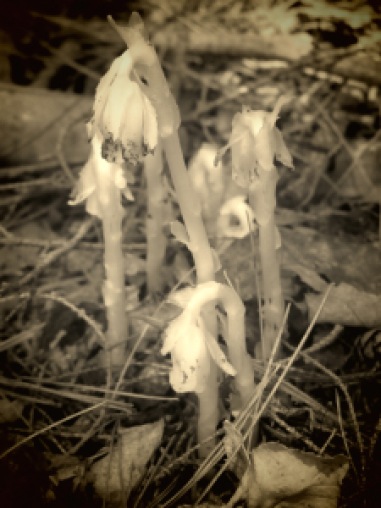 For further proof of the queer witchiness of this plant, I present you Emily Dickenson. It appears she retained a personal relationship with the Ghost Flower from childhood, and when her neighbor gifted her with a watercolor of the plant, Dickenson’s thank you letter contained tones of metaphysical shock: “That without suspecting it you should send me the preferred flower of life, seems almost supernatural… I still cherish the clutch with which I bore it from the ground when a wondering child, and unearthly booty, and maturity only enhances the mystery, never decreases it.”
For further proof of the queer witchiness of this plant, I present you Emily Dickenson. It appears she retained a personal relationship with the Ghost Flower from childhood, and when her neighbor gifted her with a watercolor of the plant, Dickenson’s thank you letter contained tones of metaphysical shock: “That without suspecting it you should send me the preferred flower of life, seems almost supernatural… I still cherish the clutch with which I bore it from the ground when a wondering child, and unearthly booty, and maturity only enhances the mystery, never decreases it.”
Oh my. Are you not convinced? Come meet this herb.
BOTANY & BIOGEOGRAPHY
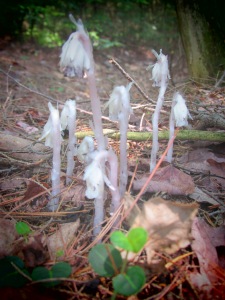 The latin binomial Monotropa uniflora indicates that a single flower grows terminally on an upright stalk in one direction, with the flower drooping its head over until it begins making seed. Monotropa uniflora is one of two species in its entire genus, its cousin being Monotropa hypopithys, or Pinesap, a similarly strange but far more colorful inhabitant of the. Formerly understood as a saprophyte which did not require chlorophyll for photosynthesis but rather took nutrients from decaying matter in the soil, Monotropa uniflora is now thought of as an epiparasite or mycoheterophyte known to survive in complex relationship with mycorrhizal fungi in the soil, which in turn interact with the neighboring photosynthesizing plants in a biome, usually the roots of a living tree such as beech, hemlock, or cedar. While the Ghost Pipe is thought to be primarily parasitic, the fungi in the soil form beneficial symbiotic relationships with the trees and shrubs, assistance in producing necessary sugars for the tree.
The latin binomial Monotropa uniflora indicates that a single flower grows terminally on an upright stalk in one direction, with the flower drooping its head over until it begins making seed. Monotropa uniflora is one of two species in its entire genus, its cousin being Monotropa hypopithys, or Pinesap, a similarly strange but far more colorful inhabitant of the. Formerly understood as a saprophyte which did not require chlorophyll for photosynthesis but rather took nutrients from decaying matter in the soil, Monotropa uniflora is now thought of as an epiparasite or mycoheterophyte known to survive in complex relationship with mycorrhizal fungi in the soil, which in turn interact with the neighboring photosynthesizing plants in a biome, usually the roots of a living tree such as beech, hemlock, or cedar. While the Ghost Pipe is thought to be primarily parasitic, the fungi in the soil form beneficial symbiotic relationships with the trees and shrubs, assistance in producing necessary sugars for the tree.
Dr. Ryan Drum explains this all so well:
Indian pipe, ghost plant, is a remarkable botanical curiosity as well as a powerful nervine. It is a mysterious, underground except when flowering, perennial common boreal non-photosynthetic flowering epiparasite. It parasitizes parasitic tree fungi, and is not dependent on one particular fungus, forming associations with at least a dozen different fungi, many of which produce edible mushrooms. It grows in complete shade on stable forest floors, usually where green plants do not. It seems completely dependent on its host fungi for organic nutrients. Its underground mass attracts fungal mycelial growth, from the fungi parasitizing live trees, both conifers and deciduous trees, providing myriad small knobbly papillar surfaces where nutrients pass from the fungal tissue to Monotropa. At least 14 species of trees can be used. I do not know if an individual Monotropa plant utilizes more than one fungal species or more than one tree species. I assume that the fungi derive some benefit from their associations with Monotropa, probably derivative secondary metabolites.
In his lovely writing on this epiparasite, Sean Donahue offers energetic observations of the plant based on its growth patterns, noting that while trees pass information and energy in a linear, centralized-library sort of stream between roots and branches, the network of mycelium and roots that Monotropa is tapped into allows for multi-directional, diffused, decentralized exchange. This interdependent physiology mirrors human neural networks, while the tender white tissues of each Ghost Pipe plant strangely resemble the structure of the mammalian brainstem. What can be seen here is the way that Monotropa interacts with the human nervous system, able to interpret, reorder and modulate large or chaotic amounts of information and stimuli.
Also, a note on herbivory: nothing seems to consider this plant a food staple.
PHARMACOLOGY & SPECIFIC INDICATIONS
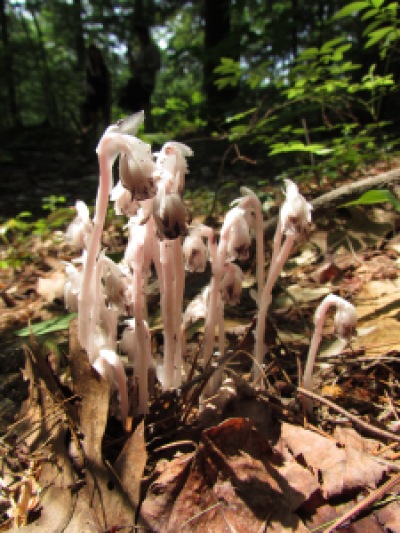 Monotropa uniflora emerges unobtrusively from the ground, quiet and still as a Greek chorus with some unanticipated piece of information on the tip of its tongue. The flowers erect and tender spines appear to hold each other up in their alignment, encouraging the clumps to hold its structure despite each plant’s delicacy and causing the herbalist to train the eyes to detect the upright patterning in the chaos of the leaf litter.
Monotropa uniflora emerges unobtrusively from the ground, quiet and still as a Greek chorus with some unanticipated piece of information on the tip of its tongue. The flowers erect and tender spines appear to hold each other up in their alignment, encouraging the clumps to hold its structure despite each plant’s delicacy and causing the herbalist to train the eyes to detect the upright patterning in the chaos of the leaf litter.
In a most general way, this profound nervine offers an quieting or cooling to an heated nervous states; older physio-medicalist texts and European documentation of First Nations traditional broadly describe the use of the herb for pain and neurological disruptions, such as seizures, convulsions, insomnia, extreme mental states, and regular muscular spasming. Felter and Lloyd, in the 1898 King’s American Dispensatory specify periodic fevers, childhood (febrile) seizures, elipectic seizures, opthamological inflammation, bladder inflammation. Most useful to me, however, have been the specific conditions or states for which the use of this plant are indicated.
I find it important to remember that Monotropa is able to help mediate both internal and external environments, whether the sensory imput comes from inside or outside us, whether it is physical or emotional. In my mind, Monotropa is the acute trauma relief precursor to Milky Oats’ tonic trauma support, creating the initial space that Milky Oats is later able to fill in a long-term nourishing way. Ghost Pipe seems to offer an aligning, re-regulating, reordering, and soothing of a chaotic mind or unmanageable pain.
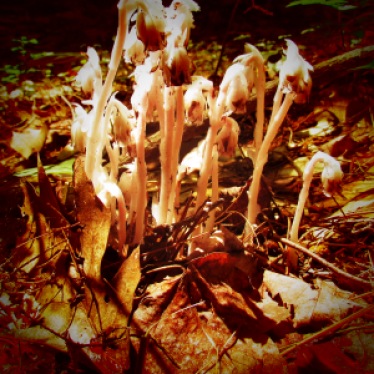 David Winston writes that Ghost Pipe is “not your normal analgesic.” Many people report the experience of taking this herb while experiencing strong physical pain and, while the pain does not go away, the individual is less attached to the pain, able to tolerate it, often feeling that they are standing beside it and watching it happen. Winston says this is called “antinociceptive,” meaning that the herb “reduces sensitivity to painful stimuli” and “raises the threshold for pain.” The same is true for emotional or psychologically painful situations, in which the person suffering is able experience relief from the intensity and to examine the experience with a little bit of spaciousness, a degree of separation. Sometimes, an individual experiences chronic or regular nervous dysregulation, either through painful autoimmune situations or extreme psychiatric states.
David Winston writes that Ghost Pipe is “not your normal analgesic.” Many people report the experience of taking this herb while experiencing strong physical pain and, while the pain does not go away, the individual is less attached to the pain, able to tolerate it, often feeling that they are standing beside it and watching it happen. Winston says this is called “antinociceptive,” meaning that the herb “reduces sensitivity to painful stimuli” and “raises the threshold for pain.” The same is true for emotional or psychologically painful situations, in which the person suffering is able experience relief from the intensity and to examine the experience with a little bit of spaciousness, a degree of separation. Sometimes, an individual experiences chronic or regular nervous dysregulation, either through painful autoimmune situations or extreme psychiatric states.
SPECIFIC INDICATIONS
+ Intense pain that interferes with ability to sleep + Painful conditions in which the individual needs to remain awake, grounded, present + Physical or emotional pain that is overwhelming + Pain that is paralyzing due to overload of sensory information, psycho-emotional shock + Anxiety or panic attack due to emotional or sensory overload + Headaches caused by traumatic brain injury + Acute psychiatric states, PTSD
PAIRINGS
+ Monotropa and Crataegus berry: vascular pressure from rebound trauma, brusing (Drum) + Monotropa and Sea Blush Roots (Plectritis congesta, a marine valerian): acute psychiatric conditions (Drum) + Monotropa and Canabis: unmanagable chronic pain (Donahue) + Monotropa, Staychys betonica, Clematis: headaches from traumatic brain injury (Donahue) + Monotropa and Anemone: anxiety, panic attack (Donahue) + Monotropa, Stachys betonica, Acorus Calamus, Ocimum sanctum: PTSD, triggering experience, disassociation, feeling stuck in memory of trauma (Donahue)
Dr. Drum notes that, while the plant’s flowering time depends on moisture, temperature, and fungal growth in the soils, the peak flowering time in much of North America appears to be July. Harvest gently to avoid bruising, wash debris away gently, tincture immediately. Flowers and roots could be used separately; using aerial parts only is advocated by Sean Donahue as most sustainable. The tincturing process results in a dark purple-black extract and a rich flavor. One friend of mine seems to think it tastes like vanilla and cinnamon. I have experimented on myself and friends according to both Donahue’s and Drum’s recommendations for dosing, which advise starting with 3 drops and increasing dose to 30 drops upon observation of reaction. For acute states, it is possible to administer or take up to 1 ml at 5 minute intervals. Dr. Drum notes that 15 ml of more can induce a deep sleep with strange, vivid, and sometimes erotic dreaming.
Be forewarned.
SOURCES
Donahue, Sean. Ghost Pipe: A Little Known Herb. American Herbalists Guild. http://www.americanherbalistsguild.com/sites/default/files/donahue_sean_-_ghost_pipe-_a_little_known_nervine.pdf
Zdenka Babikova, Lucy Gilbert, Toby J. A. Bruce, Michael Birkett, J
ohn C. Caulfield, Christine Woodcock, John A. Pickett, David Johnson. “Underground signals carried through common mycelial networks warn neighbouring plants of aphid attack.” Ecology Letters. (2013)
16: 835–843. Retrieved from http://onlinelibrary.wiley.com/
Harvey Wickes Felter and John Uri Lloyd. King’s American Dispensatory. 1898. Retrieved from http://www.henriettesherbal.com/eclectic/kings/monotropa.html
David Winston. Ghost Pipe. Facebook post. February 24, 2012.
Drum, Ryan, PhD. “Three Herbs: Yarrow, Queen Anne’s Lace, and Indian Pipe.” Retrieved from http://www.ryandrum.com/threeherbs.htm
I’m quite excited about the Aralia family. Of this family, I’m most acquainted with the elusive Panax quinqufolius, the five-leaved friend American ginseng (thanks to my time at the United Plant Savers Sanctuary), and the stately larger cousin Aralia racemosa, or Spikenard, although I have had brief lucky occasions to meet another even larger cousin, Aralia californica, or California Spikenard.
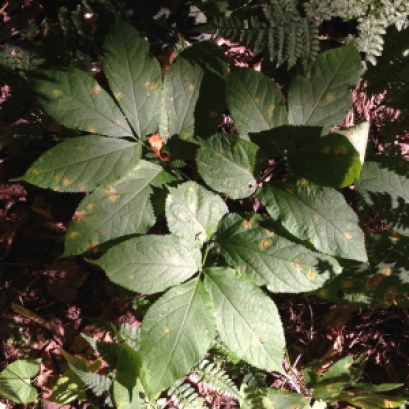
Since I’ve been living in the northern hardwood forests of Vermont, I’ve been so curious about the smaller and commoner creature Aralia nudicaulis, confusingly called many adorable names including wild sarsaparilla, false sarsaparilla, shot bush, small spikenard, wild liquorice, and rabbit root. How, I’ve been wondering, does the smaller Aralis nudicaulis compare in its medicine?
BOTANY & BIOGEOGRAPHY
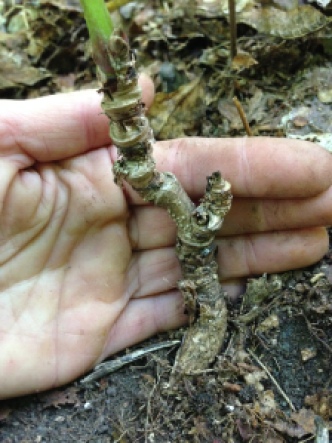 The North American Spikenards are in the Aralia or Ginseng Family (Araliaceae) and are closely related to the Apicaeae (Umbelliferae) family of Parsley and Carrot kin. The Aralias tend to have solid sturdy stems and succulent berries, ovate or egg-shaped leaves with slight serrations and fine pointed tips, delicate umbel-like flowers, and an overall elegance to their general profile. Traditionally thought to contain the strongest medicine, the root grows down directly from the stem for several inches into the soil and sends out secondary runners horizontally, from which new plants emerge, connecting the group through the forest floor. The dark purple-black fruit needs lots of moisture to germinate the seeds, however, which makes all Aralias most abundant in wet climates and far more particular about habitat than their more adaptable Carrot family relatives.
The North American Spikenards are in the Aralia or Ginseng Family (Araliaceae) and are closely related to the Apicaeae (Umbelliferae) family of Parsley and Carrot kin. The Aralias tend to have solid sturdy stems and succulent berries, ovate or egg-shaped leaves with slight serrations and fine pointed tips, delicate umbel-like flowers, and an overall elegance to their general profile. Traditionally thought to contain the strongest medicine, the root grows down directly from the stem for several inches into the soil and sends out secondary runners horizontally, from which new plants emerge, connecting the group through the forest floor. The dark purple-black fruit needs lots of moisture to germinate the seeds, however, which makes all Aralias most abundant in wet climates and far more particular about habitat than their more adaptable Carrot family relatives.
[Aralia Nudicaulis] has roots (actually underground stems) that grow laterally. This signifies communication that is dispersed in a web of synapse alongside the mycelial network. This transmits information in a matrix that, instead of being concentrated up and down, is dispersed outward where it is less centered, more continuous and evenly distributed. . . This contiguity allows for easy networking from plant to plant providing steadily accessible nutrients, perception and expression. . . When standing among a patch, or really it’s a sea, of Wild Sarsparilla there is always a feeling of aliveness, awareness and alertness but without feeling over-stimulated, as if my cells are being provided just the precise amount of energy required that can be effectively metabolized and released.
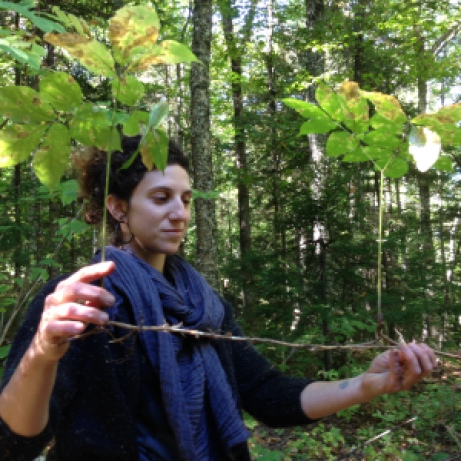 While the Aralia racemosa, which can grown to be as tall as my own five foot stature, seems to me to grow more solitarily in damp rich woods with sweeter soils, the knee-high Aralia nudicaulis seems slightly less picky, often making a thick layer in drier and more acidic soils amidst the fall of hemlock leaves. While digging Aralia racemosa is an undertaking for which I set aside at least an hour to unearth a good chunk of root and runner, Aralis nudicaulis feels like a less invasive harvest, where I can often dig from one out of every thirty plants I can see.
While the Aralia racemosa, which can grown to be as tall as my own five foot stature, seems to me to grow more solitarily in damp rich woods with sweeter soils, the knee-high Aralia nudicaulis seems slightly less picky, often making a thick layer in drier and more acidic soils amidst the fall of hemlock leaves. While digging Aralia racemosa is an undertaking for which I set aside at least an hour to unearth a good chunk of root and runner, Aralis nudicaulis feels like a less invasive harvest, where I can often dig from one out of every thirty plants I can see.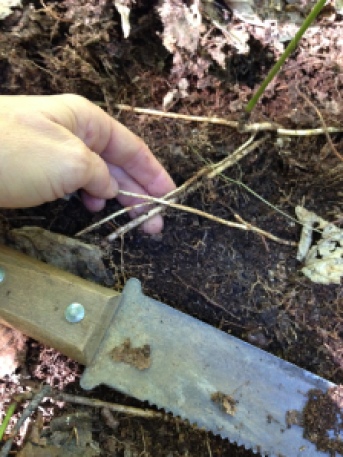
Michael Moore differentiates the Aralia genus into two distinct sorts of species, one with woods stems, acrid aromas, and spines (Aralia spinosa, or Devil’s Walkingstick) and the other which are the Aralia that we are presently mulling over, which are more characterized by juicier roots, herbaceous annual growth, a spicy sweet, cool and moist, and generally higher concentrations of saponins, aralosides, and ginsenosides. He loosely groups Aralia racemosa, Aralia nudicaulis, Aralia californica, and Aralia humulis, the last of which is primarily a creatures of the southwestern United States.
DIFFERENTIATING ARALIAS: ADAPTOGEN & PULMONARY MEDICINE
Aralias tend to have adaptogenic properties, which in Western herbalism most often means that this is an herbs which may have one or many of a broad array of tactics which assists the human in adapting to stress. In my experience, large Aralia racemosa is also a warming lung tonic which is helpful in the dampness of fall and winter in the southern climates. Other southern herbalists have expressed an opinion I share, which is that the larger and spicier spikenard possesses more adaptogenic properties than the smaller wild sarsaparilla. While many herbalists and researchers agree that the Spikenard Aralias overlaps in adaptogenic and respiratory actions, there is inevitable disagreement in how the specific indications for each species compare.
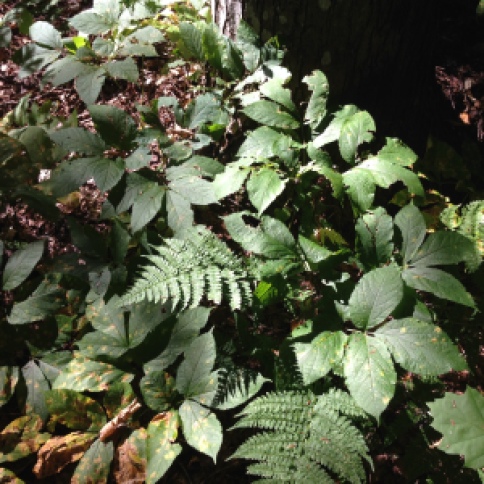
According to researchers Li, O’Neill, et al, in the Journal of Ethnopharmacology (2012), First Nations people of east Canada, including Algonquin and Iroquois people, were known to brew tea of the dried root of wild sarsaparilla for lung conditions including irritating mucous-producing coughs and tuberculosis. The researchers also noted that water extracts of the roots were show in laboratory trials to have antimycobacterial activity, which supports the use of this herb in combating the colonizing of fungus-like bacteria such as tuberculosis. Harvey and Felter, the physiomedicalists responsible for King’s American Dispensatory published in 1898, agreed that the racemosa and nudicaulis may be used similarly in cases of “pulmonary affections,” with specific indications for lax or “atonic” states of irritation and excess mucous in the respiratory tract.
Moore offers a broader usage that places Aralias in an adaptogen-like category, recommending them as long-term tonic herbs which “offer the Ginseng-like effects of modifying metabolic and emotional stresses.” He does, however, differentiate the specific indications for Aralia racemosa as more strongly pulmonary in application compared to the other three Aralias (as written in his Medicinal Plant Folios).
SPECIFIC INDICATIONS (Michael Moore, SWSBM)
Aralia Aralia californica, Aralia humilis, Aralia nudicaulis + Adrenal cortex hypofunctions + Blood serum levels: hyperlipidemia
Aralia racemosa + Chronic coughing with excess secretions; bronchorrhea + Chronic laryngitis with excess, abundant mucus + Chronic pharyngitis with thick tenacious mucus + Chronic bronchitis with profuse secretions and debility + Subacute cystitis with mucus in urine, no odor + Adaptogen similar to Panax + Adrenal cortex hypofunctions + Primipara, with irritability, distress in last trimester + Subanemic blood with hypersensitivities
BLOOD TONICS & CANCER PREVENTION
Laboratory research loves to investigate cancer-inhibiting potential in herbal medicines — cancers are, after all, devastating conditions that significantly alter a person’s existence, and of course they offer lucrative opportunity to the medical, pharmaceutical, and nutriceutical industries.
Traditional use of “blood cleansing” herbs, however, supports the use of some herbs as cancer-preventing. In his writing on herbal first aid, Matthew Wood discusses the philosophy, held in many First Nations medicine traditions as well as in Chinese herbalism, that perceives certain conditions as “stagnant blood,” indicating sluggish or inadequate circulating and poorly oxygenated blood, predisposing the body toward cancerous growth. Angelica and sassafras have both been known for their blood-moving and alterative properties in such conditions.
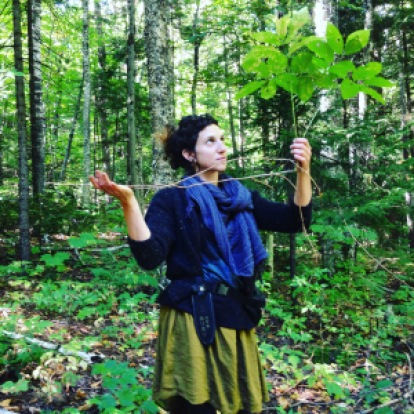 Perhaps more specific and particular than categorizing wild sarsaparilla as adaptogenic is to understand it as an alterative which offers tonifying support to adrenal function. Lisa Fazio notes that Iroquois peoples used the Aralia nudicaulis as “blood medicine,” particularly for rheumatic and diabetic situations in which circulation was impeded and therefore allowing buildup in the blood of compound which should otherwise have been excreted. In her writing on Aralia nudicaulis, she notes the following specific indications:
Perhaps more specific and particular than categorizing wild sarsaparilla as adaptogenic is to understand it as an alterative which offers tonifying support to adrenal function. Lisa Fazio notes that Iroquois peoples used the Aralia nudicaulis as “blood medicine,” particularly for rheumatic and diabetic situations in which circulation was impeded and therefore allowing buildup in the blood of compound which should otherwise have been excreted. In her writing on Aralia nudicaulis, she notes the following specific indications:
+ Excess androgens, hormone dysregulation; acnes, PCOS + Sluggish cellular metabolism + Malnourished states; depletions of calcium, potassium, magnesium, iron, and zinc + Tissue repair, including bone, connective tissue, arthritic conditions + Inflammatory join conditions, particularly auto-immune conditions + Deficiency conditions leading to muscle wasting, weight loss, and weakness
ROOTS & HONEY: HOW TO TAKE THE MEDICINE
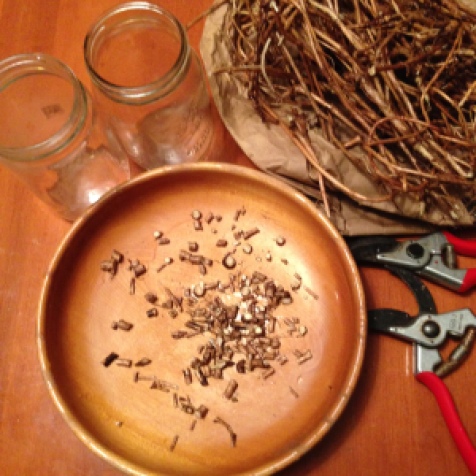 I think my approach this coming fall in understanding this medicine is going to be through the lens of re-patterning and balancing. Whatever the bio-chemical or physiological actions of these roots on the lungs, adrenals, immune cells, or circulation, the humble and sturdy Aralia nudicaulis gently urges me toward in a sideways reach, as if for a helpful hand or to collaborate, to steadily keep moving and re-moving obstacles from the path of resilience, so that the cells and tissues and mysterious systems can go about doing what they do best.
I think my approach this coming fall in understanding this medicine is going to be through the lens of re-patterning and balancing. Whatever the bio-chemical or physiological actions of these roots on the lungs, adrenals, immune cells, or circulation, the humble and sturdy Aralia nudicaulis gently urges me toward in a sideways reach, as if for a helpful hand or to collaborate, to steadily keep moving and re-moving obstacles from the path of resilience, so that the cells and tissues and mysterious systems can go about doing what they do best.
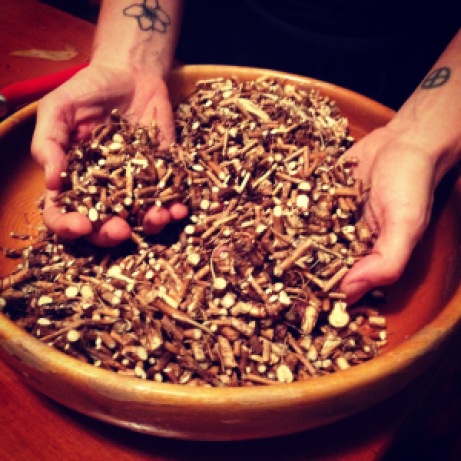 Roots are best dug in the fall or spring, and then chopped and dried for a decoction or fresh tinctured in high-proof alcohol. Harvey and Felter recommends dosage of 5 to 30 drops of the tincture in water, given 4 times per day. I have had great success with infusing fresh chopped Aralia racemosa roots in raw honey; the outcome is spicy, sweet, and warming. If you try adding an Aralia nudicaulis honey to your apothecary shelf this fall, do write and tell me your experiences! I’ll write you back with mine.
Roots are best dug in the fall or spring, and then chopped and dried for a decoction or fresh tinctured in high-proof alcohol. Harvey and Felter recommends dosage of 5 to 30 drops of the tincture in water, given 4 times per day. I have had great success with infusing fresh chopped Aralia racemosa roots in raw honey; the outcome is spicy, sweet, and warming. If you try adding an Aralia nudicaulis honey to your apothecary shelf this fall, do write and tell me your experiences! I’ll write you back with mine.
SOURCES
Li H1, O’Neill T, Webster D, Johnson JA, Gray CA. Anti-mycobacterial diynes from the Canadian medicinal plant Aralia nudicaulis. J Ethnopharmacol. 2012 Mar 6;140(1):141-4. doi: 10.1016/j.jep.2011.12.048. Epub 2012 Jan 3.
Felter, H.W., and Lloyd, J.U. King’s American Dispensatory. 1898.
Moore, Michael. Plant Folios: Aralia, Spikenard. http://www.swsbm.com/FOLIOS/AraliFol.pdf
Fazio, Lisa. Hawthorne Hill Herbs. Aralia nudicaulis. http://www.hawthornehillherbs.com/node/227
Herrick, James. Iroquois Medical Botany.
You know how a dog can be excited about the same darn ball over and over again, like every time you throw it for her its always the first time she’s ever had the opportunity to fetch anything at all?
I can be that way with plants, irrationally excited to see the same old friend who I just sat next to five minutes ago. It’s an especially prominent pattern for me up in these north woods, where I regularly meet botanical friends who are absent or uncommon in the Carolinas where I’m from.
Like Coptis.
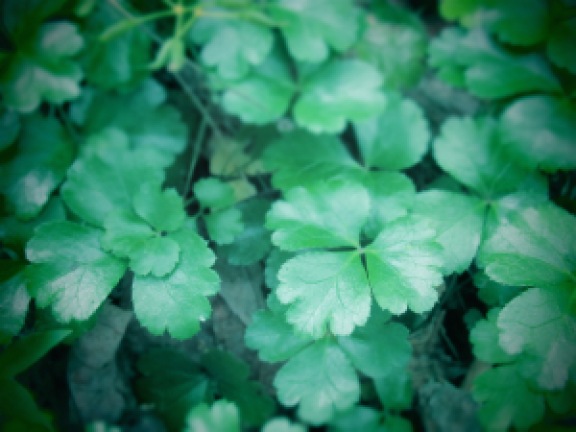 The mere sight of Coptis (Coptis trifolia, Ranunculaceae) being its green, elegant, un-assuming self has offered proof this spring of the end of cold weather. This little herb has three delicate leathery leaves and fine yellow-gold threads for roots that connect shallowly in the soil, with a flower. I think the eclectic physicians Felter and Lloyd King’s American Dispensatory (1898) wax eloquent on the botanical identification of Coptis, and I’ve rearranged their description in a sort of stanza:
The mere sight of Coptis (Coptis trifolia, Ranunculaceae) being its green, elegant, un-assuming self has offered proof this spring of the end of cold weather. This little herb has three delicate leathery leaves and fine yellow-gold threads for roots that connect shallowly in the soil, with a flower. I think the eclectic physicians Felter and Lloyd King’s American Dispensatory (1898) wax eloquent on the botanical identification of Coptis, and I’ve rearranged their description in a sort of stanza:
Rhizome, slender, creeping, bright yellow, branched
sending at intervals of four to six inches
clusters of leaves and flowers.
Leaves all radical in tufts, surrounded at base by yellowish scales;
Petiole slender, erect or reclining.
Leaves evergreen, veiny, firm, smooth, shining, palmately ternate
margins sharply, mucronately and crenately toothed,
Flowers, solitary, radical, white,
borne on a slender, erect scape and bearing, above the middle,
a single small bract.
Fruit, three to ten, dry membranous follicles,
slenderly stipitate at the base,
and tipped with the persistent curved style at the apex.
Seed five to ten,
small, horizontal, black.
Coptis aspleniifolia (spleenwort-leaf goldthread) and Coptis occidentalis (Idaho goldthread) are popular herbs native to North America. Traditionally the rhizome of this herb are the parts used medicinally. The gold indicates that this herb is one of several that contain berberine, a bright yellow-golds alkaloid that is strongly antimicrobial and soothing to inflamed tissues, famous in the treatment of bacterial, viral, fungal, yeast, and parasitic infections. I bet you’re familiar with other berberine-containing herbs, yes?
Oregon Grape (Berberis aquafolium)
Yellow Root (Xanthorrhiza simplississima)
Golden Seal (Hydrastis canadensis)
Japanese Barberry (Berberis thunbergii)
Chinese researchers Jing Liu, MD, PhD and Zhengwei He, PhD., note that coptis (Huang Lian, Coptis chinensis) is a widely used therapeutic ally in Chinese medicine, which recognizes 15 species in the genus. The ancient medical text the Divine Husband’s Classic of the Materia Medica is the first known description of the medicinal use of coptis in Chinese medicine, and it recognizes the prominent uses of the herb as heat-clearing, detoxifying, and dispelling dampness. In modern Chinese medical practice, Coptis is widely used for myriad infectious and inflammatory conditions.
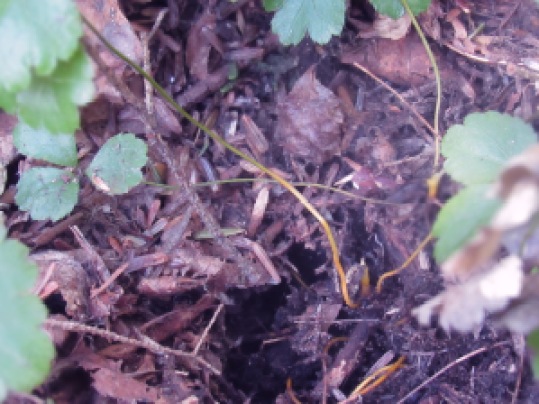
The authors further note that in particular, recent research suggests the use of Coptis for acne, GI infection involving heliobater pylori bacteria, and conditions responding poorly to antibiotic treatment. Subhuti Dharmananda, PhD, who is the director of the Institute for Traditional Medicine in Portland, Oregon, observes that the damp-heat syndromes particularly relating to GI, respiratory, and skin infections are an indication for the use of berberine herbs. Dharmananda reports that berberines have been used successfully in modern chinese medicine to treat acude cases of gastoenteritis, cholera, and bacillary dysentery, and that lab trials have shown in vitro inhibition of giardia and candida growth upon berberine applications.
While reading about Coptis, I learned that current research shows berberine-containing herbs to be useful in the prevention and treatment of insulin resistance and diabetes, cardivoascular diseases, certain cancers, and perhaps even dementia.
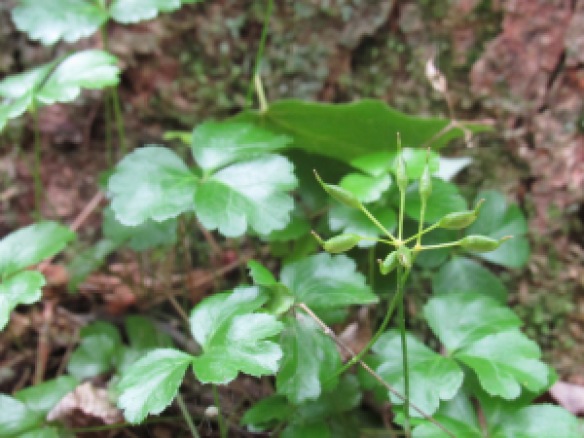
According to Dr. Julian Whitaker (http://www.whitakerwellness.com/health-concerns/diabetes-treatment/berberine-diabetes/), several threads of research indicate that an isolated berberine compound was found to be as effective as metformin, which is the most commonly proscribed drug for Type 2 Diabetes. He notes that in one clinical trial, diabetic patients with dyslipidemia (dysregulated cholesterol and triglycerides) who use a berberine supplement for three months resulted in blood sugar improvements that compared favorable with results from existing pharmaceuticals on the market. Dr. Whitaker goes on to explain how berberines work in the regulation of triglycerides and blood sugars.
“Berberine targets a very basic and ancient regulator of metabolism present in all animals and plants called AMP-activated protein kinase (AMPK).Activated by decreased ATP (energy) production, AMPK turns on multiple protective metabolic pathways to ensure survival in times of stress [. . .]”
Here are some of the things that AMPK does:
+ Increases insulin sensitivity by encouraging cells to take in glucose
+ Reduces the production of glucose in the liver, which is overactive in people with diabetes
+ Slows down the release of free fatty acid, which in turn reduces serum lipid levels
+ Stimulates mitochondrial function, which in turn produces energy for the body
+ Lowers blood pressure and prevents atherosclerosis by release Nitrous oxide, which signals arteries to relax and open, increasing blood flow
+ Regulates cancerous proliferation by inhibitsing a biochemical pathway called mTORC1, which is cell-proliferative and inhibits normal cell death (apoptosis)
Pretty nifty, eh? Suddenly it seems worth the poking and wrestling required in an Oregon Grape patch in pursuit of those golden roots.
Some words of warning, of course. In ways similar to pharmaceutical antibiotics, I have seen berberines, and goldenseal in particular, become unhelpful in cases of infection when communities of people over-use or otherwise misuse berberine herbs. Microbes seem to be able to evolve defenses against these herbs similarly to presciption antibiotics. Matthew Wood, in a paper called “Herbal First Aide,” writes that goldenseal at one point became a “fad herb” for cuts and infections because of the popular idea that is a “natural antibiotic” that will kill the germs which might infect a wound. Wood warns that, although goldenseal might be appropriate to close up a clean bleeding wound in which we might want to sprinkle golden seal powder to prevent bacterial invasion, a wound that is already dirty and infected in not an appropriate occasion for goldenseal, which may seal the inflammation, pus, and infection in (similarly to comfrey) and cause systemic infection. Additionally, Jing and Zhenwei warn that research shows a potential interference of antioxiants like berberine with chemotherapy.
At the very least, go meet the little creature. She usually doesn’t bite when you pet her.
RESOURCES
Felter and Harvey. King’s American Dispensatory. (1898) (www.henriettes-herb.com/eclectic/kings/coptis.html)
Dr. Julian Whitaker. http://www.whitakerwellness.com/health-concerns/diabetes-treatment/berberine-diabetes/
Tan W, et al. Anti-cancer natural products isolated from Chinese medicinal herbs. Chin Med. 2011 Jul;6(1):27.
Yin J, et al. Efficacy of berberine in patients with type 2 diabetes mellitus. Metabolism. 2008 May;57(5):712–717.
Zhang Y, et al. Treatment of type 2 diabetes and dyslipidemia with the natural plant alkaloid berberine. J Clin Endocrinol Metab. 2008 Jul;93(7):2559––2565.
Jing Liu, MD, PhD; Zhengwei He, PhD. Rationale and Problems for Use of Coptis and Berberine in Cancer chemoprevention. N A J Med Sci. 2008;1(1):38-43.
Wood, Matthew, Herbal First Aide.

Most researchers agree that alliums and humans have been circling around each other for at least 5,000 years, and its seems pretty likely that our paleolithic ancestors were intimate with a variety of onions and leeks long before then. The allium has been so essential to human evolution that it has left its fingerprints not only in on human nourishment and medicine but also on art and mummification.
Allium Ethnobotany
A sacred object in ancient Egyptian cosmology, the layered round structure of the onion is thought by archaeologist to have symbolized eternal life. Mummies have been found with onions in a variety of locations in the body, including inside the pelvis, in front of and inside the eye sockets, and attached to the soles of the feet. In medieval Europe, onions were offered as rent payment as well as to newlyweds as gifts, while the Pilgrims schlepped the bulbs across the ocean only to find that the indigenous folks they encountered gathered plenty of alliums from the wild.
Garlic, similarly, was cultivated in central Asia around 3000 BC from its feral form Allium longicuspis into the modern domesticated Allium sativa. Unani-tibb (Arab-Greek medicine) had a hand in helping spread the use of Garlic medicinally to Europe, refining the practice and research of medicine while Europe languished in the dark and unwashed Middle Ages. Medical texts from the middle 17th century recommended garlic for treating symptoms of plague and smallpox, and in 1858, chemists and microbiologists proved garlic to be a useful antiseptic for wound infections and dysentery, allowing the bulb to become an ally to medics during WWI and II. The ethnobotanist Daniel Moerman describes indigenous North American practices that prized ramps for their blood-cleansing properties, noting the Cherokee used the juice to treat colds and earaches.
There are times, in the dead of winter, I comfort myself by reading the names of the seed varieties in the catalogs: Nodding Onion, Babington’s Leek, Elephant Garlic, Texas Star Multiplier, Gray Griselle Shallots, Grandma Pfeifer Walking Onion. It’s not only the poetry of the varieties or the imagery of green things poking through the soil. There is something comforting in domesticity of the onion, the spicy sweet of the round-bellied bulbs and all the allium-resplendent meals that lay in the cellular memories of my taste buds.
But the Ramps. . .
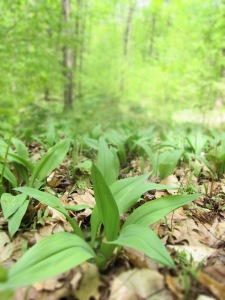
The current sexy celebrity of the allium family is, of course, ramps (Allium tricoccum). Also known as “wild leeks,” ramps have, in the last ten years of localorganicslowfoodartisinal mania, made headlines because, well, they are so wildly delicious. There are ramps festivals, ramps cook-offs, ramps recipe books, and seasonal ramps dishes at fancy (and not-so-fancy) establishments.
The thing is, ramps are particular creatures, each bulb growing a pair of leaves on inclined patches in damp and rich woodlands. This lily once ranged as far west as the Dakotas and Alabama, but the bulk of the current healthy patches now remain along the eastern edge of the continent, from north Georgia to northern New England. Like many food traditions that have long been the unadorned but well-loved practices of everyday working people, the ramps craze has come without much thought from marketers and consumers as to the stewardship of the ramps populations and the ecosystems from which they come. I know lots of folks who, as with their ginseng and morel hunting locations, guard the whereabouts of their woodland ramps patches, not out of selfishness only but out of concern for the well-being and future generation of these sweet and tender alliums.
This year, while heading up a long dirt road to the biggest patch I’d ever laid eyes on, I said hi to two folks plopped down in a smaller patch by the side of the road, who each harvested while sitting on their bums.
“Does that qualify as foraging?” my friend said to me, and I reflected that my teachers defined sustainable harvesting as leaving the bulb and roots, moving around the patch, and only taking one leaf out of every ten in a given area. Less likely if you are plunked down in one spot.
Cook + Nutrition
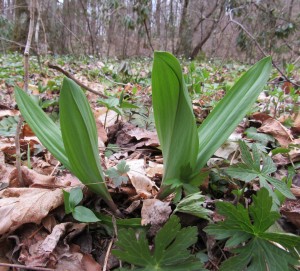
Wild foods nearly always have as dense or denser nutritional content than their domesticated kin. Like onions and garlic, ramps are high in anti-oxidants like polyphenols and cardio-protective sulphur compounds like kaempferol, which protect the epithelial lining of your vascular tissues from the scarring of oxidative stress as well as help the liver to process cholesterol. One ramp contains 10% of the recommended daily allowance (RDA) for iron. Ramps are also high in choline, a neurotransmitter needed for cognitive function, and the essential B vitamin folate.
A popular way to preserve ramps is to make pesto and freeze it. I, however, am rarely able to delay gratification when ramps are in season, feeling that the greatest way to appreciate this ephemeral treat is to sautee them fresh with butter and eat them thus with every meal while my small harvest lasts. The trick to cooking ramps is to sautee (or grill them!) them quickly and lightly or add them in at the end (like in eggs). If you needs some more ideas for ramps recipes, check out these at Serious Eats or the Huffington Post.
That’s how famous these allium are.
RAMPS FESTIVALS
Helvetia, WV. www.helvetiawv.com/events/helvetia_ramps/helvetia_ramps.htm
Hudson, NY. http://www.rampfesthudson.com/
Flagpond, TN. http://www.flagpond.com/festival/ramp/fest.htm
Ramps Dinners, The King of Stink. http://www.kingofstink.com/
Feast of the Ramson. http://www.richwooders.com/ramp/ramps.htm
RESOURCES
Jess Schreibstein, “In The Land Of Wild Ramps, It’s Festival Time.” NPR. http://www.npr.org/sections/thesalt/2013/05/08/182354602/in-the-land-of-wild-ramps-its-festival-time
The History of Onions. National Onion Association. http://www.onions-usa.org/all-about-onions/history-of-onions
“The Sustainability of Harvesting Ramps.” http://botanicalposters.com/blog/129/the-sustainability-of-harvesting-ramps/
“History of Garlic.” Vegetable Facts. http://www.vegetablefacts.net/vegetable-history/history-of-garlic/
Philipp W. Simon. “The Origin and Distribution of Garlic: How Many Garlics Are There?” Vegetable Crops Research Unit, Department of Horticulture, University of Wisconsin, Madison, WI 53706. http://www.ars.usda.gov/Research/docs.htm?docid=5232
Scott Sheu. Foods Indigenous to the Western Hemisphere: Ramps (Allium tricoccum), Wild leek, Wild Garlic. http://www.aihd.ku.edu/foods/Ramps.html
Julie Daniluk, R.H.N. “Ramp up your heart health with wild leeks.” Chatelaine. http://www.chatelaine.com/health/diet/ramp-up-your-heart-health-with-wild-leeks/
Julie R. THomson. “Ramps Are Here! Stop Freaking Out And Go Make These Recipes.” The Huffington Post. http://www.huffingtonpost.com/2015/04/10/ramp-recipes_n_1428780.html
Laurel Randolph. “15 Recipes to Celebrate Ramps.” Serious Eats. http://www.seriouseats.com/2015/04/ramp-scallion-spring-recipes.html
“Here’s 10 Ways to Cook with Ramps from you CSA.” New York Times Cooking. http://cooking.nytimes.com/68861692-nyt-cooking/1188870-heres-10-ways-to-cook-with-the-ramps-from-your-csa